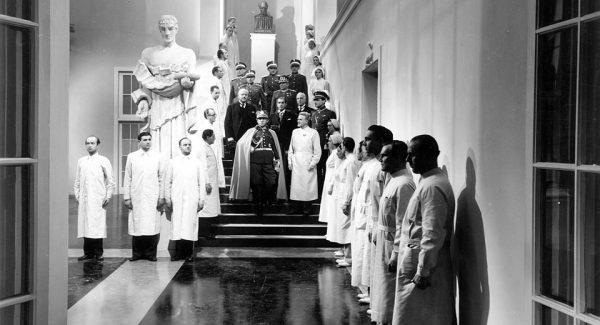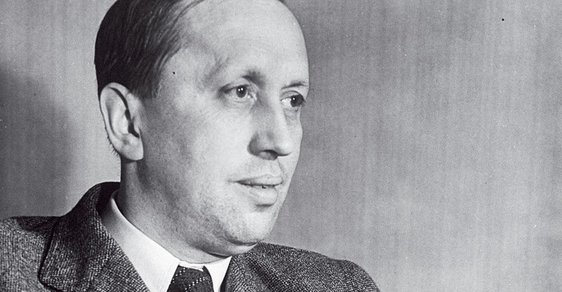Arts Commentary: Pestilence on Stage, Part One — Karel Čapek’s”The White Plague”
By Bill Marx
The White Plague uses dread to shock us into empathy for ourselves, to be alarmed by the fragility of our bodies as well as the resources and ethics of the medical system.

David Lovejoy and Venice Averyheart in the Trap Door Theatre’s 2019 production of The White Plague. Photo by Chris Popio.
“Reading is an infection,” writes Jill Lepore in her recent New Yorker piece about “fables of contagion,” “a burrowing into the brain: books contaminate, metaphorically, and even microbiologically.” But what about dramas of contamination? Wouldn’t watching a stage production about disease dig deeper into the brain, defile the mind more fully? Does our revulsion at bodily degradation become less powerful in the theater? Does recourse to makeup inevitably turn catastrophe into camp? Or does eyeballing physical decomposition challenge tidy boundaries — by highlighting how disease exposes the fragile line between the living and the dead? (A question explored in Katherine Ann Porter’s story about the 1918 Influenza pandemic, “Pale Horse, Pale Rider.”)
How has the theater represented pestilence over the centuries? Dramatists have shied away from a direct confrontation. Disease has been a crucial element in a few classics, but as an off-stage presence, referred to rather than spotlit. There have been some oblique masterstrokes. In Oedipus Rex, Sophocles brings the plague on stage, brilliantly. When the blind prophet Tiresias calls the king “the plague,” the accusation generates a kind of diagnostic terror. Sophocles’s imagery suggests that the ruler standing in front of us is also acting as the state’s physician — who is refusing to heal the sickened city and himself. I would argue that, in terms of the significance of disease in theater, the tragedian set the bar: the plague has been seen less as a sign of fate (Freudian or otherwise) or the capricious will of God than as a symptom of radical political/social/biological disorder. (I will take up Antonin Artaud’s infamous essay “The Theater and the Plague” another time.)
For example, the coming of the Bubonic plague to London in the early 1600s inspired Ben Jonson’s savage satire The Alchemist. In the 1610 play, Lovewit is typical of a class of real-life well-heeled runaways who temporary abandoned their homes for safety in the burbs. (Jonson was one of them, leaving his family in London.) Taking advantage of his master’s absence, Jeremy, the butler, adopts the persona of Face and invites the charlatan Subtle (masquerading as a doctor of alchemy) and his prostitute companion, Dol Common, to hang out with him in the Blackfriars home. The upscale digs serves as their supposed alchemical laboratory, the headquarters for their various scams. Interpretations of their hustling varies. Some see Face and his fellow swindlers as concrete manifestations of the disease, the underclass let loose to pillage. But, for me, Jonson uses all the moneymaking bunco to caricature the skullduggery of the moneyed elite (represented by Lovewit), who are more interested in profits than cures.
Like Sophocles, Jonson brings the plague in front of us in a powerful if indirect way. Lovewit returns home when he believes it is safe (he stays away “While there dies one, a week, / O’the plague”), but he is wary. Some during the period claimed that corrupted human breath could transmit the disease, which explains Lovewit’s nervous instructions to a servant (who insists he has not been ill) to “Breathe less, and further off.” No doubt Jonson knew that the show’s audience members, hearing that line, would look nervously at those seated around them. The plague was not entirely gone in 1610. Sadly, once our theaters are open again, Jonson’s joke will once again raise the same dark comic alarm.

A scene from 1937’s The White Disease (also known as Skeleton on Horseback).
Regarding the plague on stage, I will have more to say about Oedipus Rex and The Alchemist. I will also write about Peter Barnes’s Red Noses (in which victims of the black death expire on stage) and Tony Kushner’s Angels in America. But I want to focus now on a little-known 1937 play (at least in America) that has striking political and cultural resonances in our era of COVID-19. Czech writer and playwright Karel Čapek‘s The White Plague (a 1937 film version is called The White Disease aka Skeleton on Horseback) proffers a strong antiwar theme, but it does so by putting a plague on stage, raising thorny issues about the miasma of ideology, the abuses of state-sponsored physicians, class privilege, and the connections between disease and militarism.
Čapek’s setup: a pandemic is ravaging the world, killing people over the age of 50 within three weeks after they contract the virus, which first hardens and then breaks down the body. (The first sign of infection is a white spot, the disease originates from China, and people are discouraged from shaking hands.) In a nameless country, an amalgamation of Hitler-led Germany and Czechoslovakia, Doctor Galen discovers a cure. But he won’t tell what’s in his miracle compound unless the state’s fascist leader, the Marshal, calls off the war he is preparing for. Until that happens, Galen will only treat the impoverished — not the rich. At first, there is resistance to the doctor’s offer: the medical establishment knows he has come up with the real thing, but it is in thrall to the Marshal. Some doctors profit by supplying bogus cures to the desperate wealthy. (Čapek wrote a letter insisting that he did not have Czechoslovak doctors in mind.) Still, the efficacy of Galen’s vaccine is quietly acknowledged, though military bigwigs, faced with saving themselves or refraining from war, will not turn pacifist. But when the Marshal contracts the virus, he agrees to Galen’s demands. But the good doctor, on his way to treat the ruler, is killed by a mob revved up by the state’s bellicose rhetoric, mass psychosis insuring that war and the virus will ensure a worldwide death sentence.
Yes, the didactic script contains its share of clunky expressionist strategies. The thinness of its characters is testified to by the many generic names (Father, Mother, Son, Daughter, and First Clinic Assistant). And the plot smacks of recycled Ibsen — a single truthsayer versus a corrupt society. One critic, reviewing the recent Trap Door Theatre production of The White Plague in Chicago, burlesqued it as “The Enema of the People.”

Novelist, playwright, and journalist Karel Čapek. Fascists in Germany and Czechoslovakia were enraged by The White Plague.
But I think Čapek’s script is much more interesting than that, and not only because of its resonances with COVID-19. Galen’s idealism is as absolute in its way as the Marshal’s warmongering; both men are afflicted by a self-destructive savior complex. References to the building of “camps,” where the sick will be sent off to protect society, suggest the Holocaust to come. And Čapek is visceral rather than metaphoric about virus: he wants to contaminate the audience with his characters’ descriptions of the illness’s symptoms (much is made of limbs falling off of rotting bodies) and the script’s invitations for us to look into the hospital wards populated by the decaying and dying. In his preface to the play, the dramatist writes that “the ill and pitiful person is an impulsive and typical subject of humanity, his dependence on an obliging moral system is the deepest.” What better way to probe the wayward workings of this “obliging moral system” than to dramatize how the plague breaks down our sense of safety and order? In the theater, empathy for the “other” has become an omnipresent cliché. The White Plague uses dread to shock us into empathy for ourselves, to be alarmed by the fragility of our bodies as well as the resources and ethics of the medical system.
Čapek (1890-1938) is best known for penning one of the first literary works about robots, 1920’s R.U.R. (Rossum’s Universal Robots). To my knowledge only one of his dramas has been staged in Boston — Open Door Theater’s production of 1922’s The Insect Play, a charming ( its characters include butterflies and ants) but pointed antiwar satire. Last December, Chicago’s Trap Door Theatre presciently staged The White Plague, extending the run into January. It would be heartening to see a local theater company give this unusual script a production in the future. It is far from our usual fare. But who knows what the world will be like on the other side of this insanity? Some in the theater community are banking that it will just be an interruption in business as usual. But, after the plague, I am betting there may be a hunger for more than the same old same old.
Bill Marx is the editor-in-chief of the Arts Fuse. For over three decades, he has written about arts and culture for print, broadcast, and online. He has regularly reviewed theater for National Public Radio Station WBUR and the Boston Globe. He created and edited WBUR Online Arts, a cultural webzine that in 2004 won an Online Journalism Award for Specialty Journalism. In 2007 he created the Arts Fuse, an online magazine dedicated to covering arts and culture in Boston and throughout New England.

I recently read Capek’s War With the Newts, certainly a peculiar book but as klunky as what you describe above. I did see an interesting Boston production of R.U.R. about ten years ago directed by Wesley Savick.
But to the plague: you certainly need to evoke Artaud and his contention, I believe, that when the first pocket was picked of a plague victim, theater was born.
Damn, I missed the production of R.U.R. — I assume it was a student production? Yes, The White Plague is clunky, but I stand by my contention that an imaginative director could bring out its potential power during these plague times. A number of the critics in Chicago found a staging compelling. It certainly would beat another production of To Kill A Mockingbird or the musical 1776.
As for Artaud, this was Part One. I figured that Sophocles, Jonson, and Capek were enough in one go-around. In my next installment I will deal with Artaud and Peter Barnes’ Red Noses.
As for Artaud and Capek, here is what Artaud said to Anais Nin after he gave a reading/performance of “The Theater and the Plague”: “I want to give them [audience members] the experience itself, the plague itself, so they will be terrified, and awaken. I want to awaken them. They do not realize they are dead. Their death is total, like deafness, blindness. This is agony I portrayed. Mine, yes, and everyone who is alive.”
Capek is much more of a liberal humanist than Artaud (but then, who isn’t?) but that is very much the spirit I feel in The White Plague — the use of the plague to frighten and to awaken a sleeping populace. In Capek’s case it was to alert audiences to the growing acceptance of Fascism and its plague-like worship of death. It took courage to write and stage The White Plague in the late ’30s. Times had changed: the ignorant masses throw stones at Ibsen’s Stockmann; they kill Galen.
Here is the passage in Artaud’s “The Theater and the Plague” that Gerald Peary is referring to. He does not have it quite right. Theater is born when people — despite the fact that all is chaos, that death is omnipresent — enter the homes of the victims of the plague and steal their possessions.